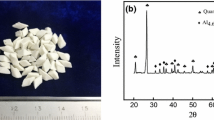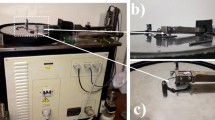Abstract
In this paper, the effect of SiO2 particle size on friction mechanisms was investigated. Five different size scales (10 µm, 80 µm, 180–700 µm, 700 µm–2.0 mm, and 3.0 mm) were selected to prepare non-commercial friction materials. Friction testing for these materials was conducted on a pad-on-disc-type friction tester under certain conditions. In order to identify the friction behaviour during the friction process, worn surfaces after test were observed using SEM. Results revealed that the friction mechanisms changed with particle size. In addition, a simple physical model was developed to provide quantitative analysis for the friction coefficient of materials containing large particles. Further, the predictability of this model was investigated across a range of formulations and controlling factors.









Similar content being viewed by others
References
Cho, M.H., Kim, S.J., Kim, D., Jang, H.: Effects of ingredients on tribological characteristics of a brake lining: an experimental case study. Wear 258, 1682–1687 (2005)
Nidhi, M., J, Bijwe, Mazumdar, N.: Influence of amount and modification of resin on fade and recovery behavior of non-asbestos organic (NAO) friction materials. Tribol. Lett. 23, 215–222 (2006)
Bijwe, J., Nidhi, M., Majumdar, N., Satapathy, B.K.: Influence of modified phenolic resins on the fade and recovery behavior of friction materials. Wear 259, 1068–1078 (2005)
Singh, T., Patnaik, A., Chauhan, R., Rishiraj, A.: Assessment of braking performance of lapinus–wollastonite fibre reinforced friction composite materials. J. King Saud Univ. Eng. Sci. 29, 183–190 (2017)
Zhu, Z.C., Xu, L., Chen, G.A.: Effect of different whiskers on the physical and tribological properties of non-metallic friction materials. Mater. Des. 32, 54–61 (2011)
Öztürk, B., Arslan, F., Öztürk, S.: Effects of different kinds of fibres on mechanical and tribological properties of brake friction materials. Tribol. Trans. 56, 536–545 (2013)
Zhao, G., Hussainova, I., Antonov, M., Wang, Q.H., Wang, T.M.: Friction and wear of fiber reinforced polyimide composites. Wear 301, 122–129 (2013)
Baklouti, M., Cristol, A.L., Desplanques, Y., Elleuch, R.: Impact of the glass fibers addition on tribological behavior and braking performances of organic matrix composites for brake lining. Wear 330–331, 507–514 (2015)
Hee, K.W., Filip, P.: Performance of ceramic enhanced phenolic matrix brake lining materials for automotive brake linings. Wear 259, 1088–1096 (2005)
Boz, M., Kurt, A.: The effect of Al2O3 on the friction performance of automotive brake friction materials. Tribol. Int. 40, 1161–1169 (2007)
Hamid, M.K.A., Stachowiak, G.W., Syahrullail, S.: The effect of external grit particle size on friction coefficients and grit embedment of brake friction material. Procedia Eng. 68, 7–11 (2013)
Matějka, V., Lu, Y.F., Jiao, L., Huang, L., Martynková, G.S.: Effects of silicon carbide particle sizes on friction-wear properties of friction composites designed for car brake lining applications. Tribol. Int. 43, 144–151 (2010)
Ma, Y.N., Martynková, G.S., Valášková, M., Matějka, V., Lu, Y.F.: Effects of ZrSiO4 in non-metallic brake friction materials on friction performance. Tribol. Int. 41, 166–174 (2008)
Shin, M.W., Kim, H., Jang, H.: Effect of the abrasive size on the friction effectiveness and instability of brake friction materials: a case study with Zircon. Tribol. Lett. 55, 371–379 (2014)
Lee, E.J., Hwang, H.J., Lee, W.G., Cho, K.H., Jang, H.: Morphology and toughness of abrasive particles and their effects on the friction and wear of friction materials: a case study with zircon and quartz. Tribol. Lett. 37, 637–644 (2010)
Cho, K.H., Jang, H., Hong, Y.S., Kim, S.J., Basch, R.H., Fash, J.W.: The size effect of zircon particles on the friction characteristics of brake lining materials. Wear 264, 291–297 (2008)
Bijwe, J., Aranganathan, N., Sharma, S., Dureja, N., Kumar, R.: Nano-abrasives in friction materials-influence on tribological properties. Wear 296, 693–701 (2012)
Ertan, R., Yavuz, N.: An experimental study on the effects of manufacturing parameters on the tribological properties of brake lining materials. Wear 268, 1524–1532 (2010)
Wang, Z.H., Hou, G.H., Yang, Z.R., Jiang, Q., Zhang, F., Xie, M.H., Yao, Z.J.: Influence of slag weight fraction on mechanical, thermal and tribological properties of polymer based friction materials. Mater. Des. 90, 76–83 (2016)
Wang, F.H., Liu, Y.: Mechanical and tribological properties of ceramic-matrix friction materials with steel fiber and mullite fiber. Mater. Des. 57, 449–455 (2014)
Eriksson, M., Lord, J., Jacobson, S.: Wear and contact conditions of brake pads: dynamical in situ studies of pad on glass. Wear 249, 272–278 (2001)
Saffar, A., Shojaei, A.: Effect of rubber component on the performance of brake friction materials. Wear 274–275, 286–297 (2012)
Glaseser, W.A.: Characterization of Tribological Materials. Harbin Institute of Technology Press, Harbin (2014)
Eriksson, M., Jacobson, S.: Tribological surfaces of organic brake pads. Tribol. Int. 33, 817–827 (2000)
Kragelʹskiĭ, V.I., Kombalov, V.S., Dobychin, M.N.: Friction and Wear Calculation Methods. Pergamon Press, New York (1982)
Blau, P.J.: The significance and use of the friction coefficient. Tribol. Int. 34, 585–591 (2001)
Briscoe, B., Scruton, B., Willis, F.R.: The shear strength of thin lubricant films. Proc. R. Soc. Lond. Ser. A 333, 99–114 (1973)
Gopal, P., Dharani, L.R., Blum, F.D.: Load, speed and temperature sensitivities of a carbon-fiber reinforced phenolic friction material. Wear 181–183, 913–921 (1995)
Acknowledgements
This work was supported by the National High Technology Research and Development Program (“863” Program) of China under grant number SS2015AA042502.
Author information
Authors and Affiliations
Corresponding author
Rights and permissions
About this article
Cite this article
Sun, W., Zhou, W., Liu, J. et al. The Size Effect of SiO2 Particles on Friction Mechanisms of a Composite Friction Material. Tribol Lett 66, 35 (2018). https://doi.org/10.1007/s11249-018-0987-0
Received:
Accepted:
Published:
DOI: https://doi.org/10.1007/s11249-018-0987-0




